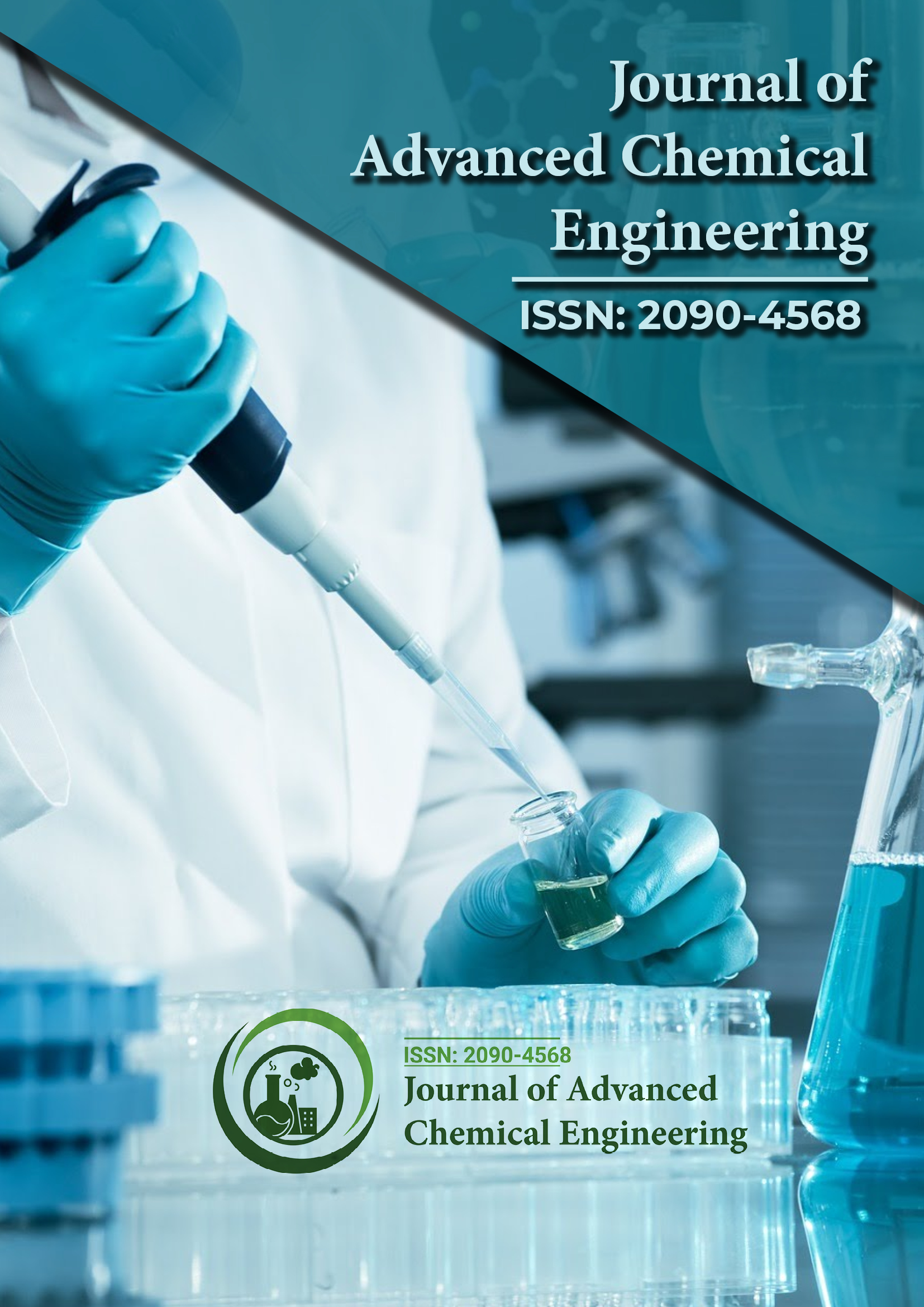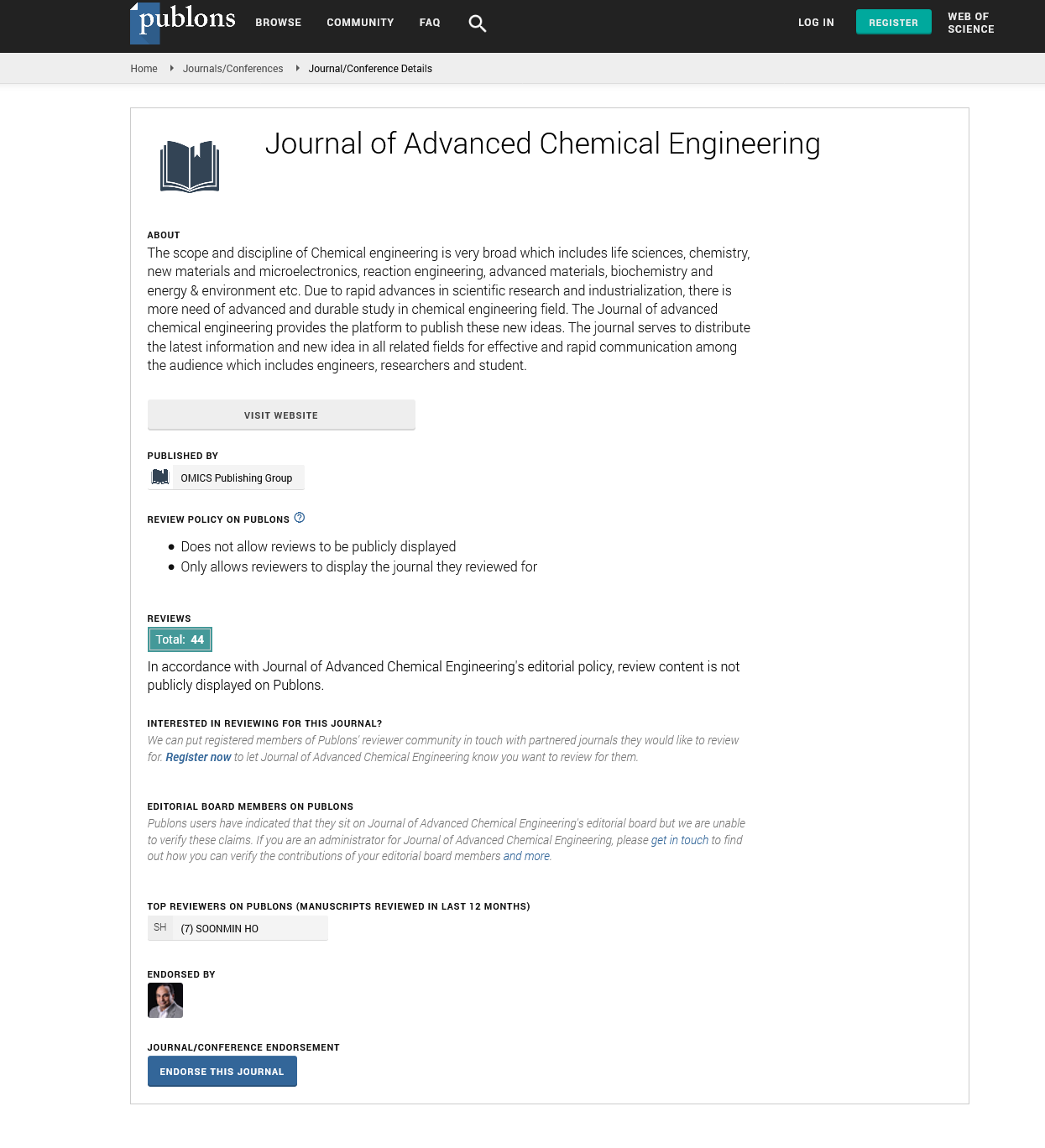Indexed In
- Open J Gate
- Genamics JournalSeek
- Smithers Rapra
- RefSeek
- Directory of Research Journal Indexing (DRJI)
- Hamdard University
- EBSCO A-Z
- OCLC- WorldCat
- Scholarsteer
- Publons
- Geneva Foundation for Medical Education and Research
- Google Scholar
Useful Links
Share This Page
Journal Flyer

Open Access Journals
- Agri and Aquaculture
- Biochemistry
- Bioinformatics & Systems Biology
- Business & Management
- Chemistry
- Clinical Sciences
- Engineering
- Food & Nutrition
- General Science
- Genetics & Molecular Biology
- Immunology & Microbiology
- Medical Sciences
- Neuroscience & Psychology
- Nursing & Health Care
- Pharmaceutical Sciences
Perspective - (2022) Volume 12, Issue 2
A Way for Experimental Purification of Air: Adsorption
Liang Wu*Received: 02-Feb-2022, Manuscript No. ACE-22-15880; Editor assigned: 04-Feb-2022, Pre QC No. ACE-22-15880(PQ); Reviewed: 18-Feb-2022, QC No. ACE-22-15880; Revised: 24-Feb-2022, Manuscript No. ACE-22-15880(R); Published: 28-Feb-2022, DOI: 10.35248/2090-4568.22.12.212
Description
Pollutants are both natural and synthetic, are gaseous state in nature and need advanced technology to effectively remove the pollutant from an exhaust or process gas stream. Gaseous industrial pollutants include:
• Acid Gases;
• Inorganic Gases;
• Organic Gases
There are various technologies that can easily remove gaseous pollutants with adsorption as air pollution control technology for organic constituents.
Adsorption is a mass transfer technique in which a porous solid comes in contact with a liquid or gaseous stream to widely remove contaminants or contaminates by depositing (adsorbing) them onto the solid. The contaminates that are being removed are called as adsorbate, and the solid doing the adsorbing is called the adsorbent.
Adsorption devices are usually used in numerous industrial operations. In general, certain organic and inorganic composites with a molecular weight greater than 45 are likely to be a good adsorbate. Adsorption is frequently used in operations where recovery of the adsorbate is desired or if the concentration of the adsorbate is veritably low and other types of pollution treatment would be prohibitive. Some common industrial operations in which organic emissions and odors can be effectively controlled by adsorption include dry-cleaning, degreasing, face coating, rubber processing, gravure printing, and others. Adsorption can also be used to purify input or circulating air streams and in fractionization of certain gases.
The adsorption process can be both a physical and chemical process. In physical adsorption, the adsorbate molecules (the contaminate) stick to the adsorbent accoutrements in a physical bonding force referred to as “van der Waals forces”. In chemical adsorption, a chemical bond is created between the adsorbate and adsorbent. This bond is referred to as “chemisorption.” Chemisorption generally occurs at elevated temperatures when energy is necessary to break chemical bonds. Chemisorption is basically the same process as catalytic oxidation.
The most common adsorbents used in industry are activated carbon, silica gel, activated alumina (alumina oxide), and zeolite. Some of the characteristics important to adsorbent selection are port size and distribution, flyspeck size, chemical nature, surface area, and surface polarity. Polarity determines the type of adsorbate for which any particular adsorbent will have the best performance. Activated carbon is the most common non-polar adsorbent. Polar adsorbents have a great attraction to absorb humidity. Since utmost industrial exhaust streams contain moistness, the use of polar adsorbents is significantly limited for air pollution control systems.
The most effective manner for promoting adsorption is in a packed bed through which the polluted air stream being treated passes. As the stream passes through the bed, adsorption of the contaminates takes place, and the purified air exits the packed bed. An adsorbent has a fixed volume of contaminates that it can hold. The exact capacity is based on numerous factors and is referred to as the adsorption isotherm. One way to think about the adsorption capacity is to consider a common sponger holding onto water. In this example, water is the adsorbate and the sponge is the adsorbent. The sponge has numerous pores in which to adsorb the water. Once these pores are fully filled, the sponge cannot accept any further water. This is called breakthrough, where the adsorbent is fully saturated with adsorbate and is no longer effective.
There are two main types of adsorption systems; fixed bed or continuous. Fixed bed or packed bed systems are relatively simple devices. A thoughtful design will look to maximize surface area to promote full and indeed use of the adsorbent. In this system, the polluted gas enters the fixed bed vessel at the side. The adsorbent material is contained in a packed bed arrangement that allows for as important exposed surface area as possible. The contaminated air enters the activated carbon quilting and works towards the centre, where there's an exhaust distributor. The exhausted air exits the fixed bed adsorber clean of pollutants or contaminates.
Once the adsorbent is completely saturated with adsorbate (leading to breakthrough), the system requires change- out of the spent materials with new components. This is generally accomplished through a sub-contractor that specializes in adsorbent materials and service. The spent adsorbent will be thermally cleaned by the sub-contractor at out- site facilities especially designed for this purpose.
An alternate type of continuous adsorption device is a Zeolite Concentrator, or Rotary Concentrator. In these systems, a hydrophobic zeolite is designed in a monolithic rotor in which the contaminated air stream flows over a large percentage of the rotor. An integrated thermal oxidizer is used to provide desorption of the solvents from the zeolite and final destruction
The use of adsorption systems as an air pollution control or VOC abatement device has wide acceptance. These systems are particularly popular for odorous gas streams, where the offending odor is caused by veritably low concentrations of organic materials. Also, these systems can give cost effective abatement for low concentration contaminates and may indeed present a capability to recover or re-use the adsorbate. Still, there are a number of limitations that should be understood.
In general, organic concentrations greater than just a few parts per million (ppm) may complete saturation of the adsorbate and consequently require frequent media change out. Depending on the adsorbent material and the frequency of change- out, the periodic cost of operation can greatly exceed that of other treatment devices.
Adsorbers are sensitive to particulates (as mist or solids) and may create a plugging event. Pre-treatment of mists and solids perhaps needed to extend the adsorbent life and present safe conditions for operation.
VOCs with low vapor pressure tend to condense veritably fluently. Condensations can stick and accumulate on the adsorbent surface and negatively affect performance. Humidity can temporarily degrade performance. In general, if the water vapor is around 2.5 volume percent or greater, careful analysis should be conducted.
Adsorption is just one of the technologies used to remove gaseous pollutants. As mentioned, there are several other technologies that give air pollution control as well.
Citation: Wu L (2022) A Way for Experimental Purification of Air: Adsorption. J Adv Chem. 12:2122
Copyright: © 2022 Wu L. This is an open-access article distributed under the terms of the Creative Commons Attribution License, which permits unrestricted use, distribution, and reproduction in any medium, provided the original author and source are credited.

